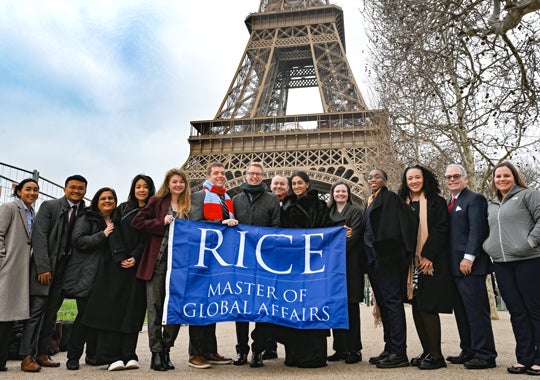A Global Lens
Rice’s Master of Global Affairs degree aims to expand students’ worldview.

Fall 2025
By Lynn Gosnell
Master of Global Affairs student Nathaniel Uy ’26 was still living in the Philippines when his sister, a registered nurse, moved to the Houston area in 2022. “She started encouraging me to [join her], but at first I didn’t want to,” recalls Uy, who worked in maritime security at an international think tank in Manila. When Uy heard about Education USA, a U.S. Department of State program which helps advise international students who want to study in the U.S., he signed up for a webinar to find out more. That’s where he learned about Rice’s Master of Global Affairs program, which checked all the boxes — professionally and personally.
Last year, Uy was admitted into the two-year, 36-credit-hour MGA program, joining a cohort of more than two dozen working adults with global experiences, backgrounds and careers. The degree is co-sponsored by the School of Social Sciences and the Baker Institute for Public Policy.
“The resources and opportunities here are amazing,” says Uy, who has embraced academic and campus life with enthusiasm — as a research intern at the Baker Institute, an RA for graduate student housing, a gallery guide at the Moody Center for the Arts and the founding leader of a new Filipino graduate student group.
Uy says his career interests have broadened thanks to faculty mentors like Steven Lewis, a renowned China and Southeast Asia scholar, and Tony Payan, an expert in U.S.-Mexico relations and cross-border studies.
Payan has taught in the MGA program since its inception in 2015 and teaches a foundational course called Global Systems every fall. A real strength, he says, is the program’s diversity of students. A cohort might include recent graduates, former or active-duty military, professionals seeking intellectual and professional growth, diplomats, and students from many different nationalities. “I think they are all richer for it, as they get to exchange views and know that there are many people that think differently,” Payan observes.
A real strength, he says, is the program’s diversity of students. A cohort might include recent graduates, former or active-duty military, professionals seeking intellectual and professional growth, diplomats, and students from many different nationalities.
For Rice alumna Maria Suarez-Simmons ’23, a highlight of the MGA program is its flexibility. “You end up crafting a two-year program that really supports your interests,” she says. As a vice president of energy policy at the Energy Workforce and Technology Council, Suarez-Simmons steered her courses toward contemporary issues related to trade and sustainable energy policy in Latin America. “Any time I had a project, a paper or a presentation for our courses, I always linked the topic to either Venezuela or energy policy, or both combined.”
She also gained deeper perspectives through an energy geopolitics class taught by Jim Krane, an expert in Middle East energy policy. “It really helped me see energy policy and its evolution over time and better understand why energy diplomacy happens the way it does.” As someone who grew up living in several countries, Suarez-Simmons found the MGA program’s diverse student enrollment — where 25% are international — to be especially enriching. In addition to adding different perspectives to critical issues, “it made me part of a community,” she says.
Last February, the MGA program launched a weeklong international masterclass at the Rice Global Paris Center, adding yet another new avenue for expanding student experience. The class provided a concentrated lesson in international policy negotiation in collaboration with the Institute for Global Negotiation, based in Zurich, Switzerland.
Learn more about the Master of Global Affairs program here.
